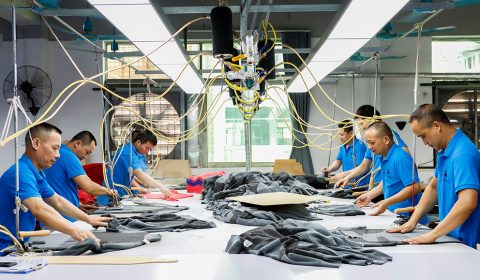The global scale of the fashion industry is huge, covering clothing, accessories, footwear and many other areas. According to the latest research data show that the global fashion market value has exceeded hundreds of billions of dollars, and continues to show a growing trend. Especially in emerging markets, such as China, India, Brazil and other countries, due to economic growth and consumption levels, the fashion market has shown a strong growth momentum.
The popularity of digital technology has also injected new impetus into the fashion industry. Digital trends such as online shopping and social media marketing make it easier for consumers to access fashion products and increase brand visibility and influence. This digital transformation is driving the continuous expansion and innovation of the fashion market.
While the growth prospects of the fashion industry are great, there are also some challenges, the most prominent of which is the continuous increase in demand brought about by the fast fashion model. Fast fashion attracts a large number of consumers with its rapidly updated products and low prices, but it also leads to excessive waste and resource consumption of consumption patterns.
The fast fashion model creates an excessive demand for raw materials and labor. In order to meet the changing trends and consumer needs, fashion brands need a large amount of raw materials and labor resources. This has led to environmental and labor rights issues such as deforestation, pollution, and poor labor conditions.
The fast fashion model also intensifies the frequency with which fashion products are consumed and discarded. Due to the rapid rate of product updates, consumers tend to buy new fashion items more frequently and discard old ones. This results in a large amount of waste, which increases the burden on the environment and the waste of resources.
How to find reliable suppliers
When looking for a reliable supplier, it is important to conduct thorough market research first. This means not only looking up lists of potential suppliers, but also getting a deep understanding of their reputation, quality standards and delivery capabilities. Information can be obtained by searching the Internet, attending trade shows, and consulting industry experts.
Conducting vendor background checks is critical. This includes checking the qualifications of suppliers, visiting their production facilities (if possible), sharing their experience with other customers, etc. Through these surveys, the reliability and strength of suppliers can be better understood.
The key to a long-term relationship is to build trust. This requires the establishment of good communication channels and the timely resolution of problems that arise. Have regular meetings or conference calls with suppliers to share both parties’ needs and expectations to ensure both parties are in the same boat.
Pay suppliers in a timely manner and respect the contract agreement between the two parties. This will not only increase your supplier’s trust, but also build a long-term partnership.
Overcoming linguistic and geographical barriers is one of the challenges often faced in a globalized environment. Addressing these barriers starts with a thorough market research to understand the culture, laws and business practices of the country or region where the potential supplier is located.
Use modern communication technology to overcome language barriers. Translation tools can be used for text communication, or real-time oral communication via phone or video conferencing. Make sure your team has the ability to communicate across cultures in order to better work with suppliers.
Consider finding an agent or middleman to help you deal with geographical barriers. These agents often have the localized knowledge and resources to help you work more smoothly with suppliers and ensure the smooth flow of logistics.
Building a strong supply chain network is key to overcoming language and geographic barriers. By forming partnerships with multiple suppliers, you can reduce dependence while in some cases getting better prices and service.
Solve low MOQ problem
Low Minimum Order Quantity (MOQ) is one of the challenges many small businesses and startups face when looking for suppliers. However, even with limited budgets and needs, there are ways to find vendors willing to accept low MOQ. First, establishing transparent communication is critical. Establish good relationships with potential suppliers and clearly communicate your needs and budget. You can explain your business model and expected sales volume so that suppliers understand your potential growth potential.
Looking for small or medium sized suppliers may make it easier to reach a low MOQ agreement. Smaller vendors are more flexible than larger vendors and may be more willing to offer more flexibility in terms of MOQ. You can find these suppliers through online platforms, trade shows or professional supplier databases. Talk to different vendors regularly to learn about their MOQ policies and find the best partner for you.
Considering long-term relationships with suppliers is also one way to address low MOQ. Suppliers may be more willing to lower MOQ if you can promise a stable order volume or a long-term partnership, because they can get a steady income from the long-term partnership. By establishing a close working relationship with your suppliers, you can support each other and grow together, thus obtaining better cooperation conditions.
Delivery time issue
In today’s competitive market environment, fast lead times are critical for businesses. In order to find manufacturers that can provide fast delivery times, conducting market research is a very important step. First, you can collect information through Internet searches, trade shows, and industry associations. Understand the production capacity, equipment technology and production process of different manufacturers.
Communication with existing customers or other companies in the same industry is also an important way to obtain information. By sharing your experience with other companies, you can learn which manufacturers are able to provide fast delivery, with a good reputation and reliable quality.
It is also essential to communicate directly with potential manufacturers and present your needs. Before entering into a partnership with the manufacturer, clearly express your lead time requirements and ask them to provide relevant production plans and delivery schedules. By communicating with the manufacturer, you can assess their delivery capabilities and whether they can meet your needs.




 English
English Deutsch
Deutsch Français
Français Italiano
Italiano Español
Español Русский
Русский Polski
Polski Nederlands
Nederlands Svenska
Svenska

